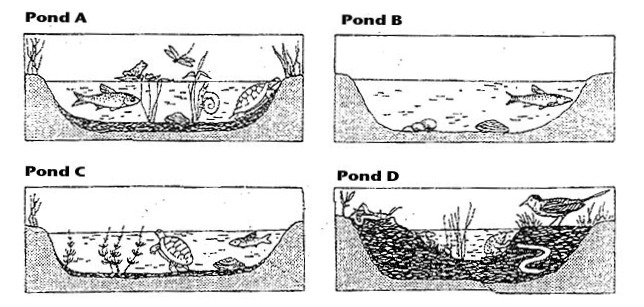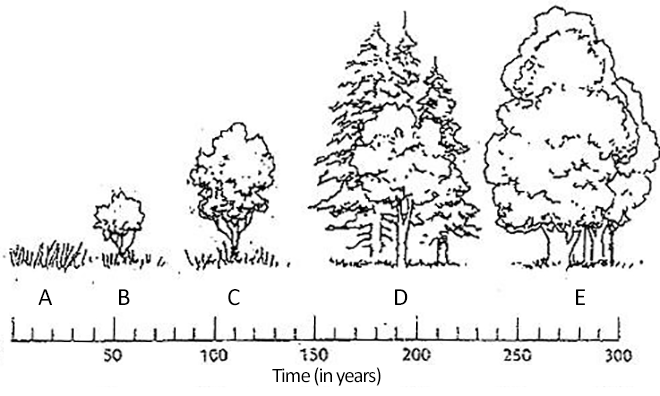
Examining the Stages in Ecological Succession in a Pond
Succession, a series of environmental changes, occurs in all ecosystems. The stages that any ecosystem passes through are predictable. In this activity, you will place the stages of succession of two ecosystems into sequence. You will also describe changes in an ecosystem and make predictions about changes that will take place from one stage of succession to another.
The evolution of a body of water from a lake to a marsh can last for thousands of years. The process cannot be observed directly. Instead, a method can be used to find the links of stages and then to put them together to develop a complete story.
The water level of Lake Michigan was once 18 meters higher than it is today. As the water level fell, land was exposed. Many small lakes or ponds were left behind where there were depressions in the land. Below are illustrations and descriptions of four ponds as they exist today. Use the illustrations and descriptions to answer the questions about the ponds.

Pond A: Cattails, bulrishes, and water lilies grow in the pond. These plants have their roots in the bottom of the pond, but they can reach above the surface of the water. This pond is an ideal habitat for the animals that must climb to the surface for oxygen. Aquatic insect larvae are abundant. They serve as food for larger insects, which in turn are food for crafish, frogs, and turtles.
Pond B: Plankton growth is rich enough to support animals that entered when the pond was connected to the lake. Fish make nests on the sandy bottom. Mussels crawl over the bottom.
Pond C: Decayed bodies of plants and animals form a layer of humus over the bottom of the pond. Chara, a branching green algae, covers the humus. Fish that build nests on the bare bottom have been replacedby those that lay their eggs on the Chara.
Pond D: The pond is so filled with vegetation that there are no longer any large areas of open water. Instead, the pond is filled with grasses. The water dries up during the summer months.
Questions
1. Write the letters of the ponds in order from the youngest, to the oldest.
2. Black bass and bluegill make their nests on sandy bottoms. In which pond
would you find them?
3. What will happen to the black bass and blue gill as the floor of the
ponds fills with organic debris?
4. Golden shiner and mud minnows lay their eggs on Chara.
In which pond would you find them?
5. Some amphibians and crayfish can withstand periods of dryness by burying
themselves in mud. In which pond(s) would they survive?
6. Dragonfly nymphs spend their early stages clinging to submerged plants.
Then, they climb to the surface, shed their skins and fly away as dragonflies.
Which pond is best suited for dragonflies?
7. In which pond will gill breathing snails be replaced by lung breathing
snails that climb to the surface to breathe?
8. Some mussels require a sandy bottom in order to maintain an upright position. In which pond would they live?
9. Suggest some animals that would live in or near pond D:
10. Pond D would also be described as a wetland. Suggest a definition for wetland:
Forest Succession
The forests, being an ecological system, are also subject to the succession process. There are pioneer species that produce great quantities of seeds that are dispersed by the wind and can colonize new spaces. They are capable of germinating and growing in direct sunlight. These plants are usually mosses and weeds, or other types of plants that grow quickly. They are then replaced by other types of grasses and even small flowering perennial plants . Perennial plants bloom over spring and then die back in the autumn, then return in the spring, like milkweed and clover.
Next, shade-tolerant species become established under the protection of the pioneers and perennials. These are usually shrubs and small trees, like blackberry and sumac. Next, trees begin to establish themselves, though at first these are softwood trees, like pines and sweetgum.
Eventually, larger hardwood trees begin to grow in this forest, like oak and maple trees. When the composition of the
forest becomes stable, or does not change drastically, the forest has reached its climax . If a catastrophe occurs, like a
fire, the opportunity for the pioneers opens up again, and the process starts over.

11. Identify using the letters on the graphic where each event occurs.
Perennial plants and grasses: _____
Pioneer species: ____
Hardwood trees, climax forest: _____
Softwood trees, like pine: ____
Shrubs and small trees: ____
12. What types of plants are pioneers? __________________________
13. What types of trees are hardwood trees? ________________________________
14. What is a perennial plant? ______________________________________________
15. Primary succession occurs when new land becomes available, like when a glacier retreats or an island forms.
Secondary succession occurs after a disturbance. What might cause secondary succession to occur in a forest
ecosystem? ___________________________________
Other Resources on Ecology
Analyzing Data - Explore Features of Biomes - Use a map and graphs to determine features of biomes
Investigating Algae Blooms - analyze and color a map showing regions of algae blooms, determine causes
Analyze Data and Create a Climate Graph - chart showing rainfall and temperatures of different regions
Exploring Range of Tolerance in Steelhead Trout - analyze a graph showing temperature and number of trout


